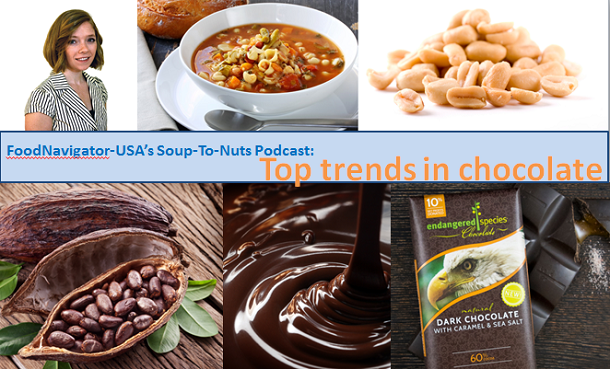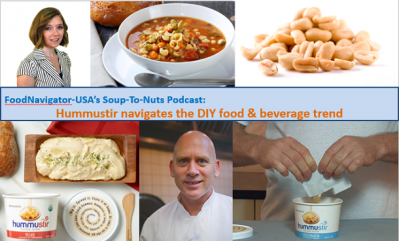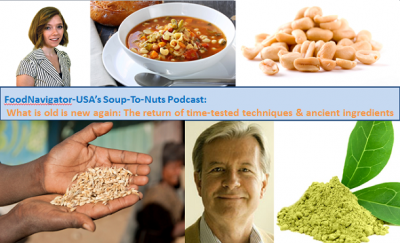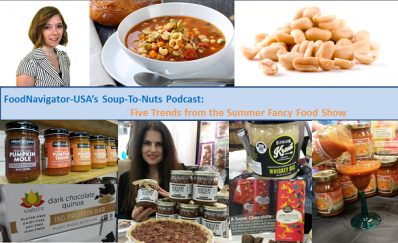Soup-To-Nuts Podcast
Soup-To-Nuts Podcast: How is consumer interest in health reshaping how they choose chocolate?

Whitney Bembenick, who is the research and development manager for Endangered Species Chocolate, explains in the latest episode of FoodNavigator-USA’s Soup-To-Nuts Podcast that consumers’ understanding of the health benefits of dark chocolate is deepening beyond a basic idea that it is heart-healthy to the point that now many consumers know which specific flavonoids chocolate must have and at what levels to deliver the most health benefit.
“It is with this evolution of education that you are seeing people go to a darker and darker profile,” Bembenick said.
But, she cautioned, not all consumers are ready for the 88% dark chocolate bar that offers the most health benefits – which is why Endangered Species Chocolate offers different levels of chocolate to ease consumers away from sweeter milk chocolates.
Beyond the shift to darker chocolates, Bembenick says consumers with an eye towards health are increasingly selecting chocolate that has inclusions, such as protein-packed nuts, nutrient dense fruit or even herbs and spices that offer health benefits.
In addition, she said, consumers are embracing thinner chocolates as a way to help them control their portions, while still feeling like they are eating the large amount.
Flavor preferences also are shifting
As American’s taste for darker chocolate develops, so too is their desire for bolder and more complex flavor profiles, Bembenick said.
“If you look at the products that are selling and doing well, they all can fit into a brown flavor category. So, you are talking about nuts, you are talking about caramels, coffees – anything that you can think of that fits into that brown flavor – that is going right to the top first,” Bembenick said. “Add a little sea salt to it and it might be going a bit higher.”
With this in mind, Endangered Species Chocolates launched a new bar in January that fits this exact profile, Bembenick said. The company’s Eagle bar is a 60% cacao with organic caramel and a touch of pink Himalayan sea salt, she explained.
“Really chocolate and caramel is an all-American classic, so we thought if we are going to do it lets make sure we do it well. So, we put it through a third party sensory panel out in San Francisco and the results came back just how we had hoped for – to say, hey, this actually exceeds our expectations,” she said, adding that the product shot up into the top three of the company’s sellers within seven months on the market.
The company’s other two top sellers also illustrate multiple other flavor trends dominating the chocolate space at the moment, including the use of extra dark chocolate, almonds and sea salt.
Bembenick explained that while the salty and sweet flavor combination is nothing new, sea salt in chocolate is taking off in part because people appreciate its role as a palate cleanser in the confection.
She explained: “It acts as a cleanser almost at the end of your palate, so when you go back for a second bite you experience everything all over again. You get the chocolate first, the fruit forwardness of the chocolate, then you get the butteriness of the caramel and then you finish with that little hint of salt.”
Spice is nice
The rise of salt in chocolate along with consumers increasing interest in botanical cocktails also opened the door for other less conventional herbs and spices in chocolate, such as cayenne and sage, Bembenick said.
“It is a delicate balance. In confectionery, you can over do it if you add too much or you don’t pair it with the right thing, then it is just flat or over-bearing and it is not an enjoyable ride,” she said. As an example, she pointed to Endangered Species Chocolate’s Blackberry Sage bar, which uses dry sage to create a “footprint so you can detect the blackberry.”
Another example is the company’s Cinnamon Cayenne Cherry bar, which Bembenick says is “a roller coaster. The cinnamon kind of warms up the palate, the cayenne starts to bring some heat and the tartness and sweetness of the cherries finishes it off so you are left with a pleasant taste, versus a burning heat that you need to drink something to get rid of.”
An evolving approach to eating chocolate
As chocolate evolves and becomes more sophisticated in the US, so too are consumers’ approach to eating it.
Bembenick said that consumers are starting to enjoy chocolate the same way they might a fine wine, which is to say with a group of friends with whom they can discuss the different flavors and aromas and explore the origin of the beans as a point of conversation at a dinner party.
Many also still see it as a snack, which means on-the-go packaging and smaller portions also are desirable, she said.
The future of chocolate
Looking forward, as chocolate manufacturers continue to raise the bar in terms of quality, Bembenick said she thinks companies will continue to try to out-do each other with certifications as a point of differentiation.
This will cut both ways, she warns. “You will see brands trying to out-do each other, but you will also see the lines blur more and there is going to be fewer points of differentiation from one brand to the next because everybody is getting to the highest standard.”
As a result, flavor will play an increasing important role, she predicts.
“I think from a perspective of flavor trends you will continue to see exploration. That is never going to end because we as consumers are explorers and we want to go on a journey and indulge in something like chocolate,” she said. “But you never are going to get away from those tried and true traditional products because at the same time you are indulging you have a little nostalgia -- a memory of your childhood, a memory of a moment in your life that brings back a feeling when you consume that product. That is what chocolate does for you. Chocolate makes you feel good – whether it is from the antioxidant power of the cocoa content or if it is just the memories and the experience so you are continue to see that push in the next five years.”
The big question for Bembenick that only time can answer is “how far do you take a traditional item before it is no longer traditional?”

















